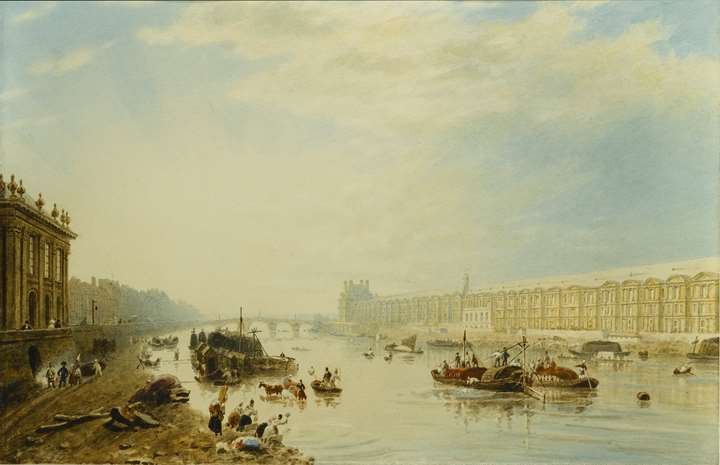Description & Technical information
The present work shows the imposing mass of St. Isaac’s Cathedral, St. Petersburg, whilst under construction. St. Isaac’s took forty years to build, from 1818 to 1858, and the present work depicts the project c. 1845. The gouache derives from a drawing by the architect of the cathedral, Auguste Ricard de Montferrand, which was engraved in book of 1845 detailing the building of the cathedral, along with accompanying plans and illustrations.¹ The view of the cathedral is from the south-east, and is very close to the de Montferrand’s engraving, with a few variations in the foreground figures. The viewer is positioned in St. Isaac’s Square, and to the right of the work Voznesensky Avenue, at the end of which the Admiralty tower can be seen.
Up until de Montferrand project, the fate of a church, dedicated to St. Isaac in St. Petersburg, had seemed ill-fated. In 1710 Peter the Great (1672-1725), built a wooden church dedicated to St. Isaac of Dalmatia, on whose feast day he had been born. However, the church was built too close to the riverbank and was quickly destroyed by floods. The architect Johann Georg Mattarnovi (d.1719) designed a second church bearing the same name which was built between 1717 and 1727. It was constructed from stone but the architect had failed to design adequate foundations. As a result, the walls were already crumbling by the middle of the eighteenth century and following a fire the church was completely dismantled. In 1768, Catherine the Great (1729-1796) decided to build another structure at the site as a monument to Peter I, for whom she held the greatest admiration. She appointed Antonio Rinaldi (1710-1794) as the architect, but his complicated marble design was never completed and Catherine’s son, Paul I (1796-1801) ordered the remaining marble to be used for his Mikhailovsky castle. He instructed his architect Vincenzo Brenna (1747-1820) to complete the St. Isaac’s Cathedral with bricks. His son Alexander I (1777-1825) deemed the cathedral unsightly and an easy target for caricature, and so ordered its demolition, and ordered a replacement to be built.
Despite much debate amongst the selection committee, it was de Montferrand’s design that was selected, in part because it conformed to Neoclassical style favoured by Tsar Alexander. The painstaking length of the build was a result of a number of factors, such as the length of time it took to provide sturdy foundations (25,000 wooden piles were used), but not least was the sheer scale and ambition of the project; the interior decoration alone took sixteen years. The project has also left its mark on the Finnish language; the expression rakentaa kuin lisakin kirkkoa (‘to build like St. Isaac’s Church’) is used in reference to projects that drag on and on.
St. Isaac’s is the fourth tallest cathedral in the world, and stands as a testament to Imperial ambition and grandeur, one of the great achievements of the vast rebuilding project that transformed St. Petersburg throughout the eighteenth and nineteenth centuries. De Montferrand was one of the key figures in this project, and just managed to live long enough to see St. Isaac’s consecrated. This picture serves as a valuable document on the development of the city, whose skyline was to be forever changed by the immense structure.
¹ Montferrand, A. R. de, Eglise Cathédrale de Saint-Isaac; description architecurale, pittoresque et historique de ce monument (St. Petersburg: Bellizard, 1845)
Date: 1845
Period: 1750-1850, 19th century
Origin: France, Russia
Medium: Gouache on paper
Dimensions: 21 x 27.5 cm (8¹/₄ x 10⁷/₈ inches)
Categories: Paintings, Drawings & Prints

Discover the gallery
Sphinx Fine Art
Old Master & Russian Paintings
More Works From This Gallery

Sphinx Fine Art
Peasants Resting Before an Inn
Johannes Lingelbach (Frankfurt, 1622 - Amsterdam, 1674)

Sphinx Fine Art
Caravan in the Desert
Richard Karlovich Zommer (Munich, 1866 - Russia, 1939)

Sphinx Fine Art
Kirghiz on a Camel
Richard Karlovich Zommer (Munich, 1866 - Russia, 1939)

Sphinx Fine Art
Russian Uralsk & Don Cossacks on the Attack
Johann Georg Paul Fischer (Hanover, 1786 - London, 1875)

Sphinx Fine Art
Portrait of a Young Woman
Alexei Alekseevich Harlamoff (Saratov, 1840 - Paris, 1922)

Sphinx Fine Art
The Seine, Looking Towards the Louvre and the Pont Royal
Frederick Nash (British, 1782 - 1856)

